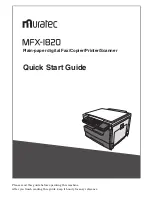
– 18 –
THEORY OF OPERATION
Fig. 2-5 Timing Chart of Non-EOI Handshake Mode
Fig. 2-6 Timing Chart of EOI Handshake Mode
(1)
Non-EOI handshake
This is a regular data transmission handshake.
1.
The host computer acknowledges that the DATA line is low (data reception is completed), raises the CLK, and
notifies the printer that the host computer is ready to send (data or commands).
2.
The printer sends information to the host computer by raising the DATA line to show that the printer is ready
to receive more data.
3.
The host computer sends information to the printer that data is available after the next raising of the CLK, by
lowering the CLK.
4.
After storing data, the host computer indicates that the data is available by raising the CLK.
The printer reads the data at the rising edge of the CLK. Then the host computer lowers the CLK and opens
the DATA line, acknowledging that the printer is in READY mode (DATA line is high), and moves to the next
bit handshake.
5.
Sending 8-bit data is the same as above. When transmission is completed, the printer sends information to the
host computer that the receiving of data is finished by lowering the DATA line.
(2)
EOI handshake
This handshake is used to show that the next data bytes are the last data.
1.
The host computer acknowledges that the DATA line is LOW (receiving data is finished), and sends
information to the printer that the host computer is ready to send data (including commands) by raising the
CLK.
2.
The printer sends information to the host computer that the printer is ready to receive data by raising the DATA
line.
At the rising edge the 500
µ
s timer starts.
(Until now this has been operating the same as the Non-EOI handshake.) From the starting of the timer, the
host computer keeps the CLK high for more than 500
µ
s to indicate EOI.
3.
If the CLK does not fall within 500
µ
s, the printer acknowledges the EOI, and lowers the DATA line to LOW.
4.
The printer sends information to the host computer that it is ready to receive data by raising the DATA line
again.
To send 8-bit data, follow the preceding Non-EOI handshake procedure.
Summary of Contents for lC-10
Page 1: ...DOT MATRIX PRINTER NX 1000SERIES LC 10SERIES TECHNICAL MANUAL NINTH EDITION ...
Page 5: ... 2 GENERAL SPECIFICATIONS ...
Page 9: ... 6 GENERAL SPECIFICATIONS Fig 1 1 External Dimensions ...
Page 11: ... 8 GENERAL SPECIFICATIONS Fig 1 3 Diagram of Internal Composition ...
Page 17: ... 14 THEORY OF OPERATION ...
Page 33: ...ADJUSTMENTS 30 ...
Page 39: ...PARTS REPLACEMENT 36 ...
Page 49: ... 46 ...
Page 53: ... 50 ...
Page 55: ... 58 REPLACEMENT AND ADJUSTMENT OF PARTS ...
Page 69: ... 66 ...
Page 71: ... 68 1 Printer Assembly Ver 1 and 1 5 1 1 Disassembly Drawing ...
Page 74: ... 71 2 Printer Mechanism Ver 1 and 1 5 2 1 Disassembly Drawing ...
Page 79: ... 76 3 3 2 Colour Type ...
Page 83: ... 80 4 Wiring Scheme of Printer Ver 1 and 1 5 4 1 Parallel Type WIRING SCHEME ...
Page 84: ... 81 4 2 Commodore Type WIRING SCHEME ...
Page 85: ... 82 5 Main Logic Board Ver 1 and 1 5 5 1 Parallel Type Ver 1 5 1 1 Component Layout A Board ...
Page 86: ... 83 B Board ...
Page 90: ... 87 Blank Page ...
Page 91: ... 88 5 1 3 Circuit Diagram Ver 1 ...
Page 92: ... 89 ...
Page 93: ... 90 ...
Page 94: ... 91 ...
Page 95: ... 92 5 2 Parallel Type Ver 1 5 5 2 1 Component Layout A Board ...
Page 96: ... 93 5 2 1 Component Layout B Board ...
Page 100: ... 97 Blank Page ...
Page 101: ... 98 5 2 3 Circuit Diagram Ver 1 5 ...
Page 102: ... 99 ...
Page 103: ... 100 ...
Page 104: ... 101 ...
Page 105: ... 102 5 3 Commodore Type 5 3 1 Component Layout A Board ...
Page 106: ... 103 5 3 1 Component Layout B Board ...
Page 109: ... 106 5 3 3 Circuit Diagram ...
Page 110: ... 107 ...
Page 111: ... 108 ...
Page 112: ... 109 ...
Page 113: ... 110 6 Power Supply Unit Ver 1 and 1 5 6 1 Circuit Diagram 6 2 Component Layout ...
Page 117: ... 114 ...
Page 119: ... 116 1 Printer Assembly 1 1 Disassembly Drawing ...
Page 122: ... 119 2 Printer Mechanism 2 1 Disassembly Drawing ...
Page 129: ... 126 4 Wiring Scheme of Printer Ver 2 ...
Page 130: ... 127 5 Main Logic Board Ver 2 5 1 Component Layout ...
Page 134: ... 131 Blank Page ...
Page 135: ... 132 5 3 Circuit Diagram Ver 2 ...
Page 136: ... 133 ...
Page 137: ... 134 ...
Page 138: ... 135 ...
Page 139: ... 136 6 Power Supply Unit Ver 2 6 1 Circuit Diagram 6 2 Component Layout ...
Page 143: ... 140 ...
Page 145: ... 142 ...
Page 148: ... 145 9 Transistor 2SD1637 10 Transistor 2SD2010 ...
Page 149: ... 146 ...
Page 150: ......
















































